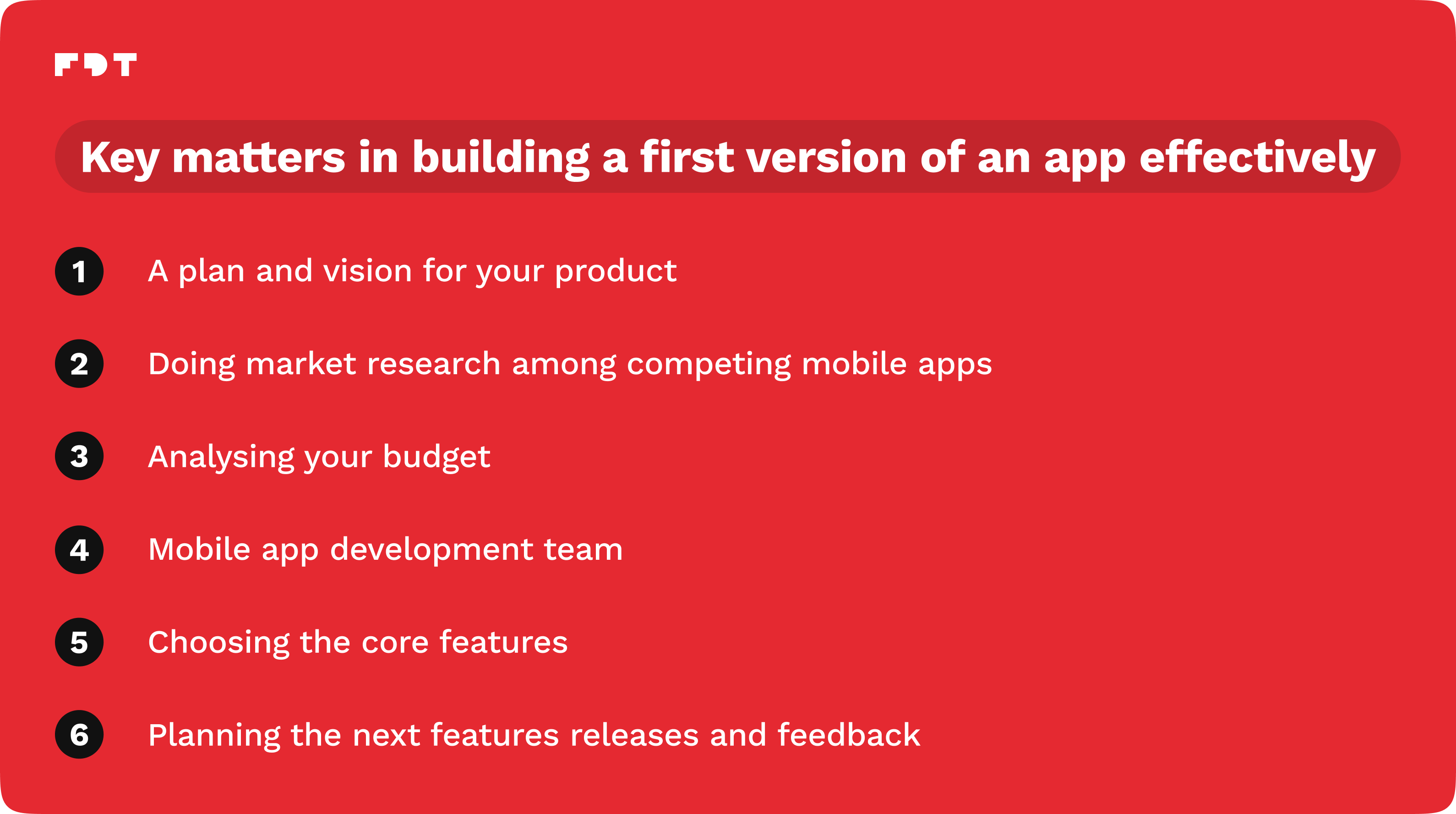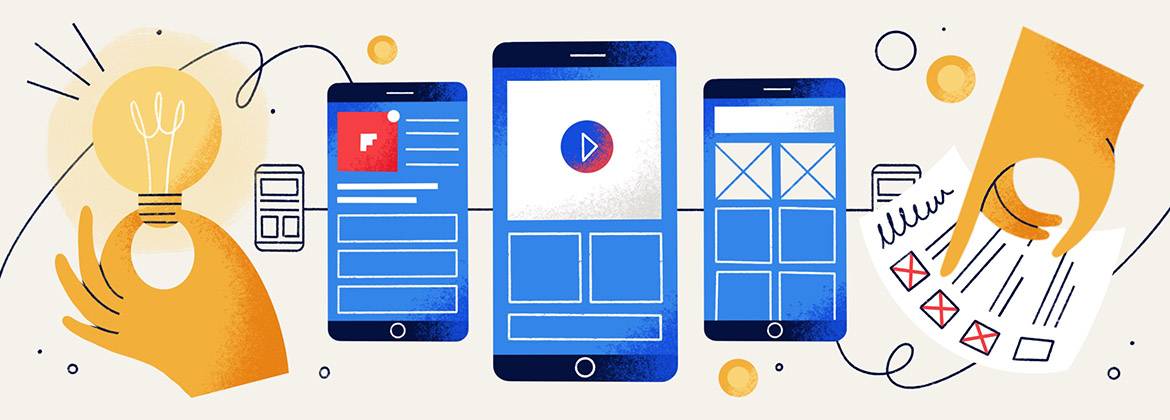
How to build the first version of your mobile app effectively?
If you’ve been thinking about creating a mobile app for your business, or about starting a business with a new mobile app, here you’ll find a couple of words about building its first version.
It is definitely a good idea to try to create a version that contains only the most important features and meets the most important objectives to plan further work based on the information you gather. The article was written with the help of our CEO and Project Manager, who shared their knowledge and experience.
But first things first:
Contents
What does it mean to build the first version of a mobile app?
There are all sorts of reasons to call the product you plan to build its “first version”. There are also different terms that are used interchangeably with the “first version”, such as MVP and MMP. It all depends on the goals of your product.
The first version of the mobile app is usually the result of a:
- limited budget
- desire to validate the idea and the product before investing more money in it.
As the name suggests, those who decide to build the first version, usually also plan to develop it further, creating the second version, third, and as many as needed. Also, as mentioned above, it’s not only done in situations where there’s a limited budget for the project.
That’s because it’s always worth checking and validating your app before investing more in it. Once you make sure the first version of your mobile app meets the objectives, it’s time to kick off with next features development!
Key matters in building the first version of a mobile app effectively – process
Let’s have a look at the most important matters when building the first version of your own app and at the whole process of building it. There are some things you should pay attention to, to make sure your app development isn’t a waste of time and money.
The first version should have particular goals and to accomplish them, you need to take care of:
A plan and vision for your product
You need to establish exactly what you want to build - what kind of product it should be, what kind of problem it should solve and what kind of functionality it should have. That is, broadly speaking, you need to know the goals and vision for the product. This will enable you to create a roadmap so that the team knows what to do, the work is structured, and there are no changes or discussions about what to build or change during development.
This will also ensure that the whole team is efficient.
You will build the first version of your mobile app effectively if you know exactly what to build.
Doing market research among competing mobile apps
There are so many apps on the market it will be hard to stand out from your competitors. It’s also unlikely to invent a mobile application that would be different from any other. That’s why it’s crucial to do the research and check what competing apps work and look like.
Do the competitive analysis among your competitors mobile apps using information from Google Play store, App Store and simply from testing different products. Pay attention to:
- Competing apps’ monetization strategies
- Features of competing apps
- Users’ reviews
- Users’ rates
- Technologies used to build these apps.
It might be hard for you to define the technologies and frameworks used in competing apps but you can try to define them with proper research. However, the more important matter in this case is how they work and how you would rate their performance.
Doing the competitor research will help you decide on what features your app should have, and maybe even what it should look like, as well as possibly help you assess whether an idea for such an app has a chance of succeeding on the market.
If you want to find out more about market research strategies, jump to this article.
Budget
Analyse your budget. If it is sufficient, start building your app in the first version on a target tech stack, in good quality. The product will then be further developed in the same technologies, frameworks and code.
However, if you don't have enough budget, choose the cheapest possible technological solution just to see if your idea has the potential to succeed. Releasing it as soon as possible will help you validate your product with the market and decide whether it is worth investing in it. However, also take into account that if you choose this way and the idea succeeds, the quality may not be sufficient and you may have to create another version of the product from scratch.
Mobile app development team
The right team is a must. That’s probably no surprise. If your business is based on a new mobile app idea, it’s probably not a very good idea to build an in-house team for product development. Lots of businesses failed by taking this approach. If it’s a new thing, brand new idea and an untested product, you should be aware of making that mistake.
The mobile app development process can last for years and this might mean you’ll need to cooperate with the development team for the whole time, that’s true. But it’s only in case the first version of your app turns out to be really successful and you decide to keep working on new features.
This may sound bitter, but the truth is, your app idea might just be wrong. Still, it doesn’t mean it’s always your fault and that you’re an unsuccessful creator. Sometimes it’s about the wrong timing, for example.
That’s why it’s so important to build the first version and check its viability before thinking about more complex features and further development. And that’s why it’s most often a good idea to outsource this task after choosing the right people.
As we are an app development agency, we can give you some tips on how to find such team:
Choosing the right people
Here’s how to find the right team for building the first version of your mobile app:
- Don’t treat research as a waste of time – it’s not only about the quality of work, although this is of course also an important factor, but you should also simply find out if there’s a fit between you and the team in terms of communication etc.
- Browse portfolios and case studies – companies most often share their previous work on different projects. It’s definitely something you should be interested in.
- Check reviews and references – what will definitely tell you a lot about the company and the team are reviews from previous partners. Pay attention to previous partners’ stages of projects.
- Take care of communication matters – when you first contact the company you don’t know, it’s very important how you like the communication with them.
If you’d like to find out more about how to choose the right app development team, check out this article.
The right partner is crucial when it comes to software development, because once you come across a company that has earned the trust of clients, it will compensate for deficiencies in the product vision documentation, as well as your lack of technical knowledge. Above all, it will let you accurately specify the scope of the first version of the product and fit this into a realistic timeframe within a far more favourable budget than the full version of the product.
Choosing the core features
When you create an app for the first version, it should contain only the core features – the most important ones. There’s no point in spending time and money for complex features and complicated app design until you’re not sure if it will be profitable. The minimum version is just what you need at this stage.
Target users should be able to test the key features and give you enough feedback to enable you to start planning the next stages. Or decide to stop the project at this point. It might happen.
Choosing the right tech stack
It’s not like you suddenly have to become a technical expert in the field of app development. You don’t need to know all technologies and frameworks that might be used for mobile app creation. However, there is also some research to do regarding this subject.
For example, based on your target audience, you can assess whether it’s better to build an Android app or iOS app, or choose a cross-platform solution (an app built for multiple platforms at the same time).
It might turn out that most of your target group are Android or iOS users and if you decide to create an app for the users of one platform, you can build a native app. It’s not like native apps are better or worse than cross-platform apps, but it simply depends on your choices regarding the app features.
Changing the tech stack for the second version of your app
Cross-platform apps are usually built faster and this solution might also be more cost-effective than creating two separate apps for two platforms. That’s why there’s also an option to choose this method to build the first version of your app and then rewrite the code and continue implementing new features with different frameworks, for example, build a native app.
Planning the next features releases and feedback
Again, don't try to create an extensive product that will take six months to create. You don't even know if the idea will catch on and you'll lose a lot of time and money. After each update, collect feedback from users, analyse the results, find out what the needs are, implement improvements and collect feedback again.
This kind of agile product development will ensure that you check as soon as possible whether your concept is relevant, whether it meets the expectations of the target group, which features are important and worth developing and which can be omitted.
Creating your product closely with users and on a data-driven basis will give you the best results.

Purpose of the first version of your product
Here are the main goals of choosing to build the first version and validating the idea before planning the next features and before building a fully-fledged product:
Showing your product to the world as soon as possible
Of course, the conclusion of the process of creating the first version of the app will be that we want to get the product out to the market as soon as possible and show our idea. This is all so that we know what there is to change, what there is to maintain, and whether there is any point in making a business out of it at all or whether the idea turned out to be wrong.
Validating your app idea
What follows, this is one of the most important reasons why business owners build the first version of their app. If you want to create a really successful app, you need to develop it according to app users’ feedback.
You can find their opinions on app stores, you can ask them directly in the app or social media, you can use any method to make sure your next steps will be profitable.
Efficiency is about vision, achieving larger goals within a specific time frame and delivering the intended value. All this within the intended budget. But when it comes to results regarding the product itself, it’s as simple as this:
An effective product = a product users love.
That’s why when building the first version of an app you should put more attention to the requirements of your target audience than on user interface, for example.
Collecting user feedback and planning further development
Take the user feedback into account and plan the releases of next versions as soon as the first one is done. It should be a continuous process and the only reason to stop it is if it turns out that the product brings bad results.
If your goal was to gain 50 downloads and collect 20 reviews in the first month, monitor these results throughout this period and plan the second release at the same time. Check the results, collect user feedback, plan the next versions, and repeat.
This way, users of your app will constantly have access to new features and be able to follow the product’s development. They’ll be even more likely to recommend it further if their opinions are taken into account and suggested improvements are implemented.
Cost cutting
You can save a lot of money for your business if you decide to build the first version of your app before creating a complex app.
Firstly, if the idea fails, you’ll stop the development and you won’t waste more funds.
Secondly, you can start making money on the app earlier, by implementing a monetization model in the first or any early version of the app and then use this profit to develop the product.
Facilitated implementation of changes
It's much harder for app developers to make changes and fixes in an extensive product than in a smaller one. Besides, changes matter less the fewer features there are, so introduced at such a time, they won't have much chance of harming your business goals. Even if you get it wrong.
Additionally, in case you need to change the team, it’s also no such big deal when your app is still quite small.
More time to analyse
While you are developing the first version of your app, you should always keep an eye on what the competition is doing. Keep an eye on whether similar solutions are being developed at the same time, whether competitors are introducing new features and whether they provide positive results.
As you plan and build subsequent versions, you have time to analyse the market and adapt to it.

Conclusion
The first version of the product has clear goals to fulfill. Thinking about it this way will allow you to do it effectively.
If you are planning an app development, there are quite a few decisions to make. That’s why it’s so important to do deep market research and pay attention to all these important matters.
Going through all the above steps will definitely help you make the right decisions regarding the first version of your app, to do it effectively and succeed.








